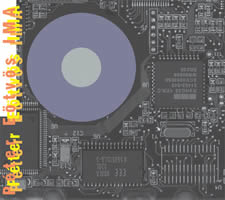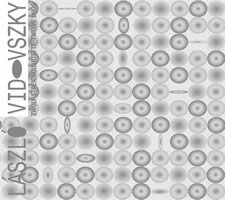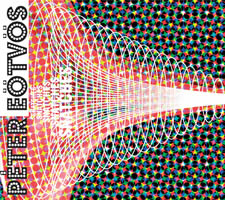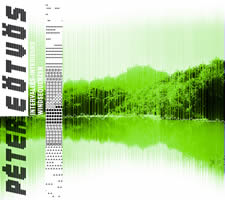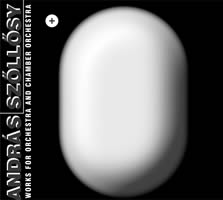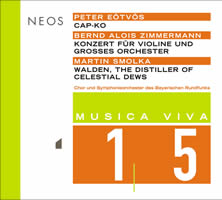Eötvös, Vidovszky, Szollosy: Hungarian Holiday 1.
|
Grant Chu Covell [April 2009.] I have been meaning to tackle some Hungarian composers and a few colorful Budapest Music Center releases for quite some time, even before Ligeti’s passing (June 12, 2006) made the stack shift ever so slightly. Since two brief visits in the late 1980s, I’ve nurtured a fondness for its contemporary music. To my ear, unquantifiable characteristics unite Hungarian composers after Bartók. Perhaps it’s their country’s history, the water, or that their language is celebrated for its uniqueness and difficulty. (I noted only three English borrowings: “bar,” “taxi” and “condom.”) Having no choice but to master Magyar, natives are generally able to pick up (or spoof) other languages incredibly easily. I’m reminded of an Ernie Kovacs joke: One guy says to another, “Do you believe in intelligent life on other planets?” The other replies, “Yes. Down here we’re called Hungarians.” My remarks focus on Péter Eötvös and two others (next we’ll visit with György Kurtág). Born and trained in Hungary, Eötvös became part of Stockhausen’s touring ensemble between 1968 and 1976. His abilities came to the attention of Boulez, who asked him to direct the Ensemble InterContemporain. He held that post between 1978 and 1991. Today Eötvös conducts everywhere and still finds time to compose. Among recent works are operas and double concertos. He is not at all afraid of electronics. (Eötvös is pronounced EUT-veush, the eu as in the French peut-être.)
“IMA.” Péter EÖTVÖS: IMA (2001-02); Cosmos* (1961, 1999); Correspondence** (1992-93). WDR Rundfunkchor Köln, WDR Sinfonieorchester Köln, Sylvain Cambreling (cond.); Andreas Grau*, Götz Schumacher* (pnos); Pellegrini Quartet**: Antonio Pellegrini, Thomas Hofer (vlns), Fabio Marano (vla), Helmut Menzier (vlc). Budapest Music Center Records BMC CD 085 (http://www.bmcrecords.hu/). Distributed in the US by Forte Distribution (http://www.fortedistribution.com/). The three movements of Eötvös’ IMA (Prayer) for electronics, chorus and orchestra deliver happy bewilderment. The sequel to his 1995 Atlantis, IMA’s texts by Gerhard Rühm and Sándor Weöres offer a valedictory benediction to the vanished or perhaps imaginary continent. To listen to the work is to be in the presence of a mysterious ritual. Except for the chromatic language, this grand work could be taken for something by Scelsi. Cosmos — begun when the composer was 17, the year Yuri Gagarin went into space — appears in a two-piano version recorded with antiphonal separation (a single-piano version appears here). Written for string quartet, Correspondences’ three scenes engage in a vigorous dialog between Leopold and Wolfgang Amadeus Mozart. The music nicely illustrates their honorees’ personas.
László VIDOVSZKY: Zwölf Streichquartette (2000); Twelve duos* (1987-89). Auer Quartet: Gábor Sipos, Zsuzsanna Berentés (vlns), Csaba Gálfi (vla), Ákos Takács (vlc); András Keller* (vln), Zoltán Gál* (vla). Budapest Music Center Records BMC CD 075 (http://www.bmcrecords.hu/). Distributed in the US by Forte Distribution (http://www.fortedistribution.com/). We’ve met Vidovszky when he was consumed with MIDI piano etudes. Here he shows another intriguing side. Vidovszky’s 12 string quartets are best presented in their entirety, and in the intended sequence. They range in duration from 0:53 (No. 3) to 8:41 (No. 6) without apparent pattern or design. Each quartet embraces a particular idea, mood, style or technique close to obsessively. This gentle mania and intentional constraint does disorient inasmuch as the 12 quartets appear to be dissimilar yet together present a family of individuals. There are many puzzles and subtle moments: No. 4’s continuing drone, No. 5’s whispering pizzicato, No. 6’s alarm-siren glissandi, No. 7’s knocking, etc. From approximately 12 years earlier comes another dozen, a sequence of duos for violin and viola. The instruments appear as if conjoined in an eight-stringed device. The duo’s patterning seems less restrictive than the 12 quartets. Folksong-like phrases briefly float by within the shortest duos. The longer ones may stumble, then resume. (Vidovszky is pronounced much as it looks to American readers: VI-dof-ski.)
“Snatches.” Péter EÖTVÖS: Snatches of a conversation* (2001); Jet stream** (2002); Paris-Dakar*** (2000). Béla SZAKCSI and Gábor GADÓ: Jazz improvisations on themes from Eötvös’ opera Le Balcon. Marco Blaauw* (double-bell trpt), Omar Ebrahim* (speaker), musikFabrik Ensemble für Neue Musik*, Péter Eötvös* (cond.); Markus Stockhausen** (trpt), BBC Symphony Orchestra**, Péter Eötvös** (cond.); László Goz*** (double-bell trb with harmonizer), Budapest Jazz Orchestra***, Gergely Vajda*** (cond.); Béla Szakcsi (pno), Gábor Gadó (e-guit). Budapest Music Center Records BMC CD 097 (http://www.bmcrecords.hu/). Distributed in the US by Forte Distribution (http://www.fortedistribution.com/). “The three composed pieces are a ‘message in a bottle’ from my world to those who like jazz,” says Eötvös. This recording of the trumpet concerto, Jet stream, is immensely preferable to the one Håkan Hardenberger and Eötvös captured for DG (477 6150) which never gets off the ground. This strange collection begins with Omar Ebrahim’s closely miked theatrical rasp in Snatches of a conversation and ends with two improvisations on themes from Eötvös’ opera Le Balcon. While I’ve an open ear for jazz, I couldn’t fall in with the improvisations. Making for amusing listening, the trombone concertino, Paris-Dakar, easily straddles the jazz-classical line. These recordings are extraordinarily fine, capturing the stage-front soloists and the supporting ensembles’ nuances. In Jet stream, this means the gentle background veils, and for Paris-Dakar, the jazz band’s crisp force.
Péter EÖTVÖS: Intervalles-Intérieurs (1974-81); Windsequenzen* (1975-2002). UMZE Chamber Ensemble: Csaba Klenyán (clar), Aurél Holló (perc), Anna Mérey (vln), György Déri (vlc), Michael Svoboda (trb), Péter Eötvös (cond.); Klangforum Wien*: Eva Furrer (fl), Markus Deuter (ob), Donna Wagner Molinari, Bernhard Zachhuber, Ernesto Molinari (clars), Gérard Buquet (tuba), Uli Fussenegger (bass), Krassimir Sterev (accordion), Lukas Schiske (perc), Péter Eötvös (cond.). Budapest Music Center Records BMC CD 092 (http://www.bmcrecords.hu/). Distributed in the US by Forte Distribution (http://www.fortedistribution.com/). The 30-minute Intervalles-Intérieurs is a meticulously rendered scroll painting for clarinet, cowbells, violin, cello and trombone playing over a tape Eötvös and Mesias Maiguashca fashioned in 1972-74 with electric organ, filters and ring modulators. With its shifting subtleties, the work amounts to an unpredictable, absorbing event. The more opaque eight-part Windsequenzen swirls spectral harmonies with an Eastern flair. Progressing slowly, the high winds billet thick chords that lead to a final summation from accordion and tuba.
András SZŐLLŐSY: Musica per orchestra (1972); Sonorità (1974); Musica concertante (1973); Elegia (1993). BBC Symphony Orchestra, Péter Eötvös (cond.); Budapest Chamber Symphony, “The Weiner-Szász Orchestra,” András Wilheim (cond.). Budapest Music Center Records BMC CD 080 (http://www.bmcrecords.hu/). Distributed in the US by Forte Distribution (http://www.fortedistribution.com/). As Köchel is to Mozart and Deutsche is to Schubert, so Szőllősy is to Bartók. Perhaps you’ve only seen its abbreviation: Sz. Beyond cataloguing Bartók, Szőllősy is also an estimable composer in his own right. The hefty Musica per orchestra and Sonorità with their strong colors and massed effects recalling Ligeti’s Atmosphéres from a decade before, Szőllősy builds his works from overlapping motivic fragments, creating stern rhythmic and contrapuntal structures. With its flush unisons the two-section Musica concertante reveals a neo-classical feel. Elegia brings canonic writing into a lighter mixture. As an exercise in frustration, the notes emphasize the importance of two works, Concerto III and Trasfigurazioni, neither of which figures here. Concerto III appears on the 2002 Hungaroton HCD 31727 along with a sampling of small-to-medium chamber pieces of solemn mood: Tristia for 16 strings, a six-voice Miserere, Paesaggio con morti (Landscape with corpses) for solo piano, Fragments setting István Lakatos’ desolate texts for mezzo, flute and viola, and a Passacaglia, Achatio Máthé in memoriam, for cello with string quartet. One additional work, a ribald setting for six voices, Fabula Phaedri, crisply performed by The King’s Singers, who also do the Miserere, enlivens the mood. (Szőllősy is pronounced SOEUL-loeu-shi, the oeu as in the French coeur.) Szőllősy’s One Hundred Bars for Tom Everett (1981) appears on trombonist David Taylor’s manic release, complete with three bongos (Gordon Gottlieb) and a central, multiphonic chorale (New World Records 80436-2).
Péter EÖTVÖS: As I Crossed a Bridge of Dreams (1999); Tale (1968). Elizabeth Laurence (recitation), Mike Svoboda (double-bell alto trb), Gérard Buquet (double-bell cb trb, sousaphone), UMZE Chamber Ensemble, Gergely Vajda (cond.). Budapest Music Center Records BMC CD 138 (1CD and 1DVD-A) (http://www.bmcrecords.hu/). Distributed in the US by Forte Distribution (http://www.fortedistribution.com/). As I Crossed a Bridge of Dreams’ premiere appears on the Donaueschinger Musiktage 1999 release (col legno WWE 2CD 20075). In this more definitive version Eötvös achieves a more ideal spatialized mix over a period of several years. The piece is characterized as “sound theatre,” basically a radio play. The present release offers an audio DVD in multi-channel DTS or Dolby 5.1 formats. The DVD’s remixes are longer than the CD version in order to accommodate the enriched playback medium. Delivered in English, the texts are taken from the diary of one Lady Sarashina (b. 1008). The music unfolds as a somewhat creepy, surreal exposition of her dreams, which we are likelier to hear as thinly veiled desires. Eötvös must like this material. His one-act opera Lady Sarashina (2007) premiered in Lyon in 2008. The DVD also includes the original three-channel version of the electroacoustic Tale, previously remixed for stereo on BMC 038.
“Musica Viva 15.” Péter EÖTVÖS: CAP-KO (2005). Bernd Alois ZIMMERMANN: Concerto for Violin and Large Orchestra (1950). Martin SMOLKA: Walden, The Distiller of Celestial Dews (2000). Pierre-Laurent Aimard (pno, keyboard), Paul Jeukendrup (digital-piano programming), Martin Mumelter (vln), Wolfram Winkel (perc), Robert Blank (chorus master), Chor des Bayerischen Rundfunks, Symphonieorchester des Bayerischen Rundfunks, Péter Eötvös (cond.). NEOS 10705 (http://www.neos-music.com/). Distributed in the US by Qualiton (http://www.qualiton.com/). Eötvös’ CAP-KO, i.e., Concerto for Acoustic Piano, Keyboard and Orchestra, should be the focus here. Aimard switches between a piano and synthesizer programmed to double the played pitches. The flow alternates between the keyboards so that material expressed by one is developed by the other. The work is dedicated to Bartók, whose piano-and-percussion music hovers at the margins. The attractively zingy CAP-KO is a bit more approachable than the trumpet concerto Jet Stream. Zimmermann’s concerto perhaps meant more in the mid-20th century when the last thing anyone anticipated from him was a violin concerto proportioned along Romantic lines. Smolka’s Thoreau settings for chorus and percussion strike me as odd. Are these simplistic melodies intentional or the best its composer can do? The Eötvös and Smolka were recorded in early 2006 (CAP-KO’s premiere), the Zimmermann in 1989. Eötvös’ concerto is easy to discover, whereas Zimmermann’s requires an ever-so-slight suspension of disbelief.
[More Grant Chu Covell, Hungarian Holiday]
[Previous Article:
Andriessen at 70 I: Italienisches Liederbuch (Bitte um Verzeihung, Herr Wolf)]
[Next Article:
Springtime with Bach]
|
